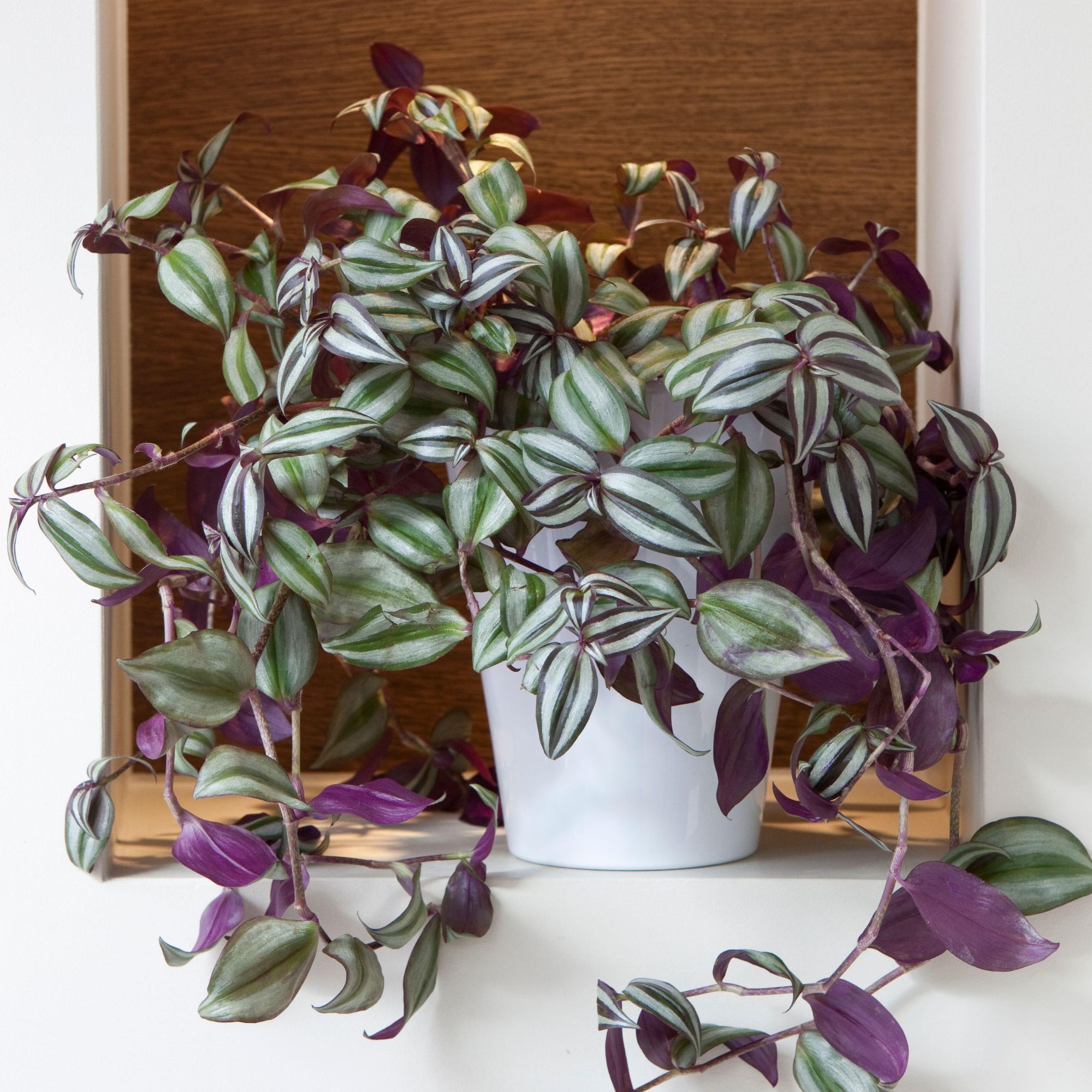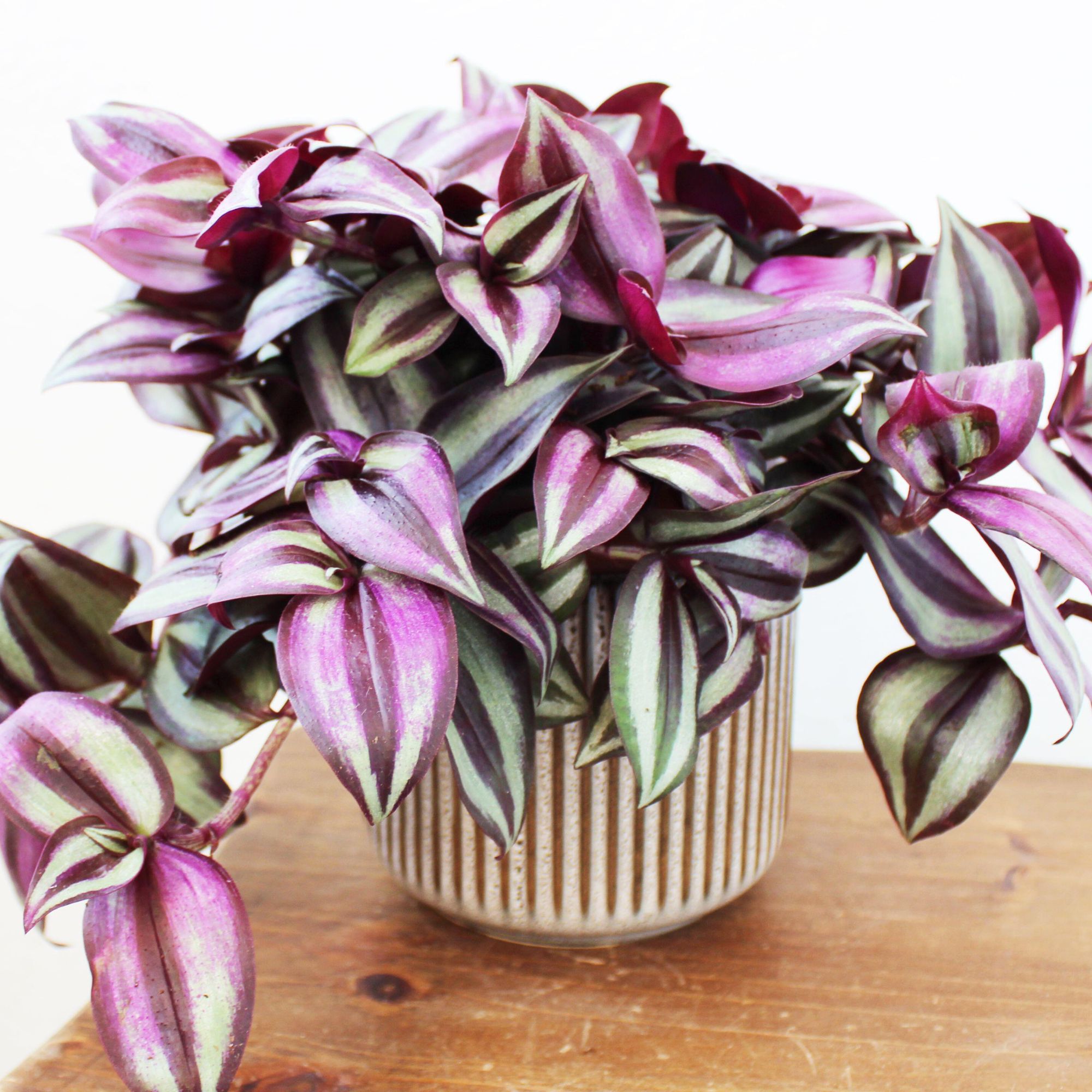
Learning how to care for tradescantia is surprisingly straightforward so long as you follow a few essential rules.
One of our favourite colourful and low maintenance houseplants, tradescantia zebrina is perfect for beginners and experts alike.
'Tradescantia is a gorgeous houseplant, with many varieties from which to choose. Tradescantia has many common names from the ‘Inch plant’ to the ‘Wandering Dude' – it is a genus of around 85 different species,' says Natalie Bourn, shop manager at Between Two Thorns.
It is really easy to learn how to care for tradescantia and this fast-growing houseplant will reward you with eye-catching leaves and pink-purple flowers.
Tradescantia zebrina is instantly recognisable with its long trailing vines and unique leaves. The topside of the leaves features an unusual silver and green striped pattern, which has a subtly metallic appearance in the light, while underneath is a striking magenta shade.

‘Tradescantia is one of my favourite houseplants as they are so easy to care for,’ says Sonia Kanith from House of Kojo. Due to their colour, pattern and zest for life, they are a great houseplant to boost mood at home, too.
When it comes to the real vs faux houseplant debate – tradescantia zebrina is so easy to care for that it's only marginally more work than a faux design.
Where to buy tradescantia zebrina
One of the best indoor plants, tradescantia zebrina is commonly available in most garden centres and occasionally in some supermarkets. You can also purchase online from a range of reputable sellers.
When looking for an online stockist look for one that offers a good return/guarantee policy to give you peace of mind when ordering.
Your tradescantia care rules
Perfect placement

If you're in search of houseplants that are easy to care for then look no further than Tradescantia zebrina.
Native to Central America and Mexico, tradescantia zebrina thrives in a warm location that receives bright indirect light. When choosing a spot, Natalie from Between Two Thorns advises ‘avoiding somewhere that receives direct sunlight as this will burn the leaves and cause the colour to bleach. At the same time, too dark a spot will cause the colours on the leaves to fade and the plant to become leggy.’
For perfect light levels, consider hanging it in an east or west-facing window or placing it on the windowsill for a pretty living room houseplant idea. Just ensure that there are no draughts and there is not a radiator underneath as the dramatic changes in temperatures can shock the plant.
Go easy on the watering
Less is more when it comes to watering this houseplant. Tradescantia zebrina likes to maintain slightly moist soil without being waterlogged– a pot with good drainage holes is a must.
Prevent overwatering by checking the soil first – ‘simply push your thumb into the top of the soil and if it feels dry your plant is ready for water,’ explains Morag Hill, co-founder of The Little Botanical.
As a general rule, Natalie advises ‘watering tradescantia zebrina approximately once a week during the summer.’ But come the colder months, this should be reduced even further. 'Throughout autumn and winter, reduce the frequency of watering as the plant goes will go into dormancy and its growth will slow,’ advises Sonia from House of Kojo.
During these months, testing the soil becomes even more important as the plant will be more vulnerable to overwatering and root rot. If your trandescentia is showing signs of overwatering – i.e. the soil not drying out and the plant is limp – then make sure you know how to save an overwatered plant.
To prevent root rot, Morag advises only bottom-watering tradescantia. ‘Take it out of its cover pot and place it in a sink of water for about 20 minutes. Let it drain and then return it to its decorative pot.’
You don't necessarily need to mist

For the most part, tradescantia will be able to thrive in typical household humidity levels, so it doesn't necessarily need to be misted.
However, this doesn’t mean they wouldn’t welcome being placed in a kitchen or bathroom or receiving a regular misting with water – especially if you’ve got the heating on.
Make sure to fertilise
A standard houseplant fertiliser – like this balanced Houseplant Focus fertiliser from Amazon – is the best choice for a tradescantia zebrina.
‘Tradescantia are hungry plants during the growing season. I suggest fertilising once a week to once every two weeks in the spring and summer months,’ advises Sonia.
Repot only when required

Tradescantia zebrina are one of the houseplants that like to be pot bound and repotting is only needed when the plant shows signs of having outgrown its pot. These include: the soil drying out very quickly; the roots growing through the plant’s drainage holes; growth slowing down or the plant looking lacklustre.
If you're wondering when to repot houseplants – specifically tradescantia zebrina – then Sonia has some words of advise. 'Repotting is typically needed every 1 to 2 years,’ says Sonia Kanith from House of Kojo. ‘Early spring is the ideal time to repot when the plant is coming out of dormancy. We would suggest a simple yet well-draining potting mix.’
Knowing how to repot houseplants is also essential to ensure that you don't damage your tradescantia zebrina.
Prune for a fuller figure

While tradescantia do not require pruning to thrive, however, doing so will help to encourage new growth, resulting in a bushy and well-shaped houseplant.
‘As your plant becomes more established, it may start producing lengthy stems. ‘When these start to develop give it a prune to ensure it stays bushy, instead of leggy,’ explains Natalie.
To prune, simply use a pair of snips or secateurs – cleaned with a bleach-free disinfectant to prevent introducing infections – and remove any long, straggly stems.
You can also use these cuttings to create new plants by learning how to propagate tradescantia – it's surprisingly easy and very rewarding.
FAQs
Why are my Zebrina plant leaves turning yellow?
If the leaves of your tradescantia zebrina are turning yellow, then chances are, you're overwatering. Reduce watering frequency and always test the soil’s moisture level before watering.
Why is my Tradescantia losing its color?
Tradescantias tend to lose colour when there is not enough light. ‘Try moving the plant to a brighter spot,’ advises Sonia from House of Kojo.
How do you fix leggy Tradescantia?
A leggy-looking Tradescantia is another sign that more light is needed. ‘The plant is literally stretching out in search of light,' explains ’ says Morag Hill, co-founder of The Little Botanical. 'To remedy this, give it a good trim and move it to a spot where it gets more natural light. This is particularly important in winter as the days are getting shorter.'







